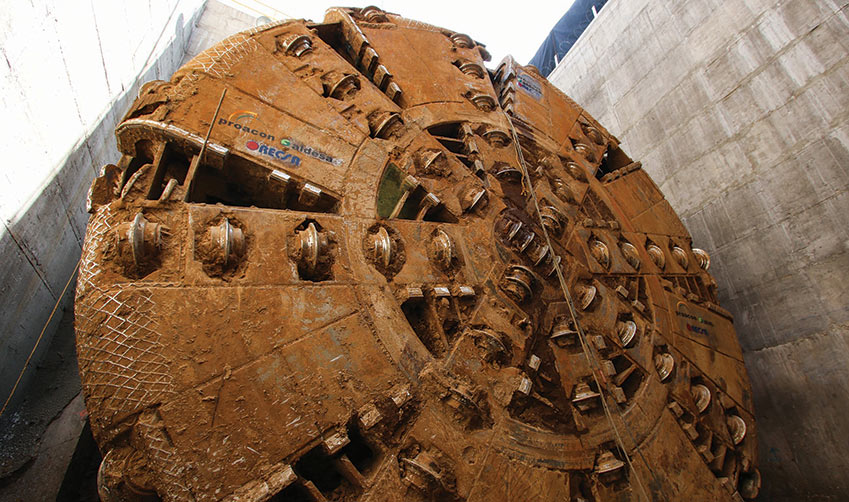Mexico City XRE TBM finishes on a high note 13 Jul 2017
A group of distinguished officials, including the President of Mexico, Enrique Peña Nieto, celebrated the final breakthrough of an epic tunneling project, both for Mexico and the international tunneling industry. The 8.7m (28.5ft) diameter Robbins Crossover TBM, the first such hybrid machine to operate in North America, completed the Túnel Emisor Poniente (TEP) II project and on a high note.
The TBM, known an XRE (crossover (X) between rock (R) and EPB (E) TBMs), navigated fault zones, variable ground, low cover and more, to achieve a national record of 57m (187ft) in one day and a maximum of 231m (758ft) in one week and 702m (2,303ft) in one month.
“The XRE has a major advantage as it is designed to work in open and/or closed mode, allowing it to excavate the tunnel either in soil or in rock,” said Ing Juan Alberto Herrera Moro y Castillo, Section Chief of the TEP II project, for owner the National Water Commission or Conagua. “We have verified that its performance was very efficient.”
The TBM and its Robbins continuous conveyor mucking system were built on location using onsite first time assembly (OFTA), and is designed for the contractor consortium of Aldesem, Proacon, and Recsa. The machine featured components including a convertible cutterhead with interchangeable cutting tools, interchangeable TBM belt conveyor and screw conveyor, and multi-speed gearboxes to increase torque for tunneling through difficult ground.
“The benefits of the design are manifest in its exceptional thrust power and in the ease of changing the cutterhead torque,” said Alberto Martinez, head of the tunneling department for Recsa. “This makes the process much easier should the machine become stuck in difficult ground.”
The XRE machine was launched in August 2015 to excavate the 5.8km wastewater tunnel and began in a hard rock configuration, mounted with 20in diameter disc cutters. Early in 2016 the TBM hit a 30m wide fault of fractured and blocky rock, the first of several contact zones on the alignment. While the excavation through the contact zone was slow going, progress picked up again in the more competent andesite rock to achieve an intermediate breakthrough in March 2016 into an 80m deep shaft. Following inspection and maintenance, it continued on.
While boring in fractured andesite rock in Autumn 2016, the TBM encountered a naturally occurring cavern believed to be the result of a rockfall in a transition zone or eroded from the rock by an old, underground lake body. The cavern was estimated at 90m3, including about 57m3 of unstable floor area. The TBM was stopped and immediate measures were taken to stabilize the ground in front of the machine with polyurethane foam before filling the cavern with a mixture of pea gravel and grout.
By the end of October, the machine had reached a final 900m section of soft ground, where it was converted to EPB mode. In this final reach of low cover, the distance from the top of the tunnel to residential home foundations was as low as 4m, less than half a tunnel diameter, and the ground had the consistency of reconsolidated soil. To stabilize the soils and minimize the risk of settlement below the residential area, the tunneling crew drilled from the surface and installed 890 micro-piles at 1m intervals. “We were able to do this without causing damage to property in the zone bordering the path of drainage tunnel alignment, or to the road or the urban infrastructure installed in that area,” explained Ing Francisco Miguel Lopez, the project Jobsite Manager for contractor Aldesa.
With final TBM breakthrough in early June completing all excavation, the tunnel is now being finished with secondary cast concrete lining of 35cm thick before going into service. The wastewater tunnel will overhaul the current system in western areas outside of Mexico City and serve to prevent recurrent flooding in Valle Dorado. In particular, the tunnel will benefit the cities of Cuautital Izcalli, Tlalnepantla, and Atizapan de Zaragoza, which altogether are home to 2.1 million inhabitants.
References
- Mexico City manages mega drainage projects – TunnelTalk, May 2013
- First Crossover TBM for the USA – TunnelTalk, June 2017
- Success for first North American Crossover TBM – TunnelTalk, May 2016
- Crossover TBMs bridge the gap – TunnelTalk, March 2015
- North American debut for new-design TBM – TunnelTalk, June 2014
|
|
|
|
|
Add your comment
- Thank you for taking the time to share your thoughts and comments. You share in the wider tunnelling community, so please keep your comments smart and civil. Don't attack other readers personally, and keep your language professional.





